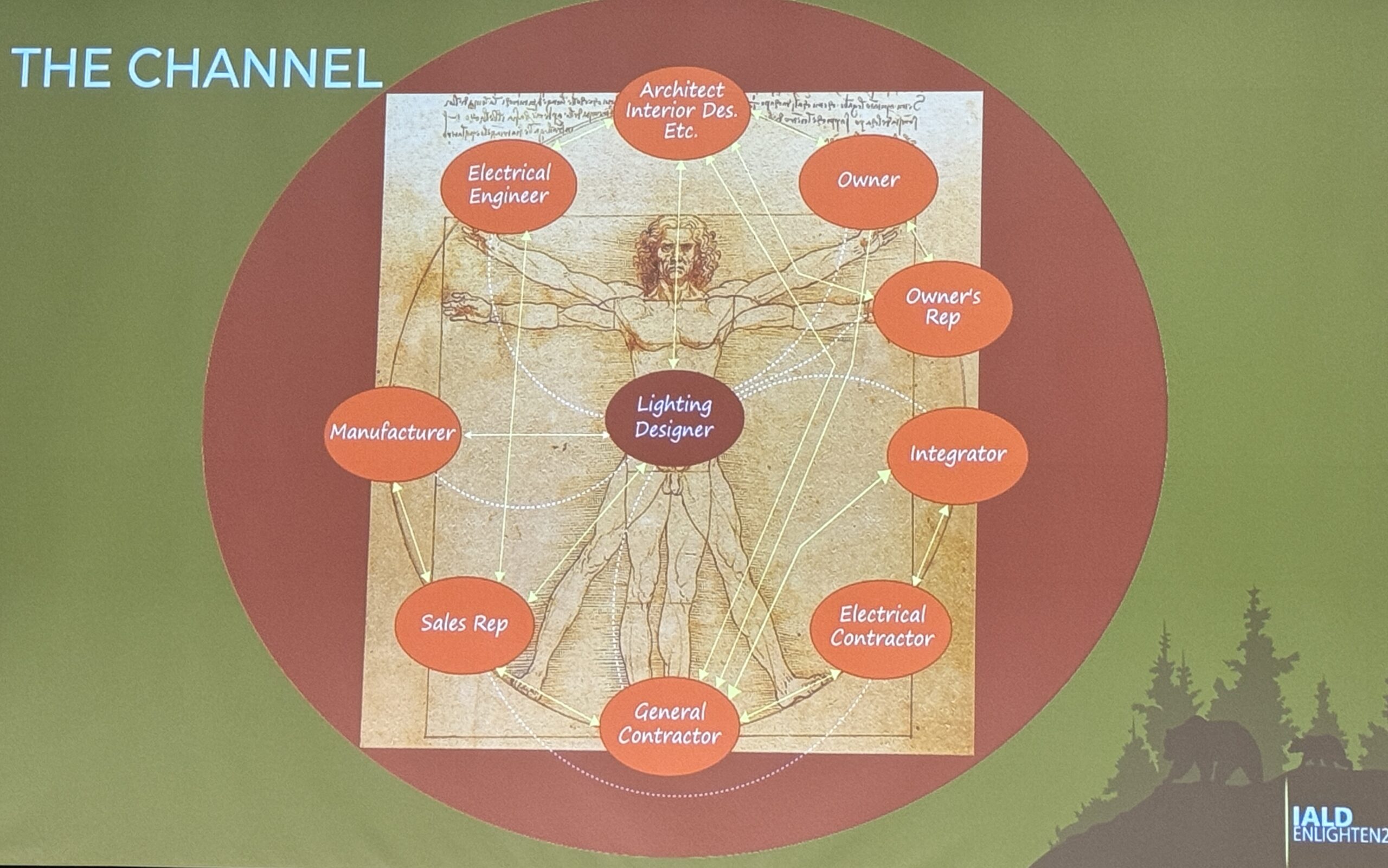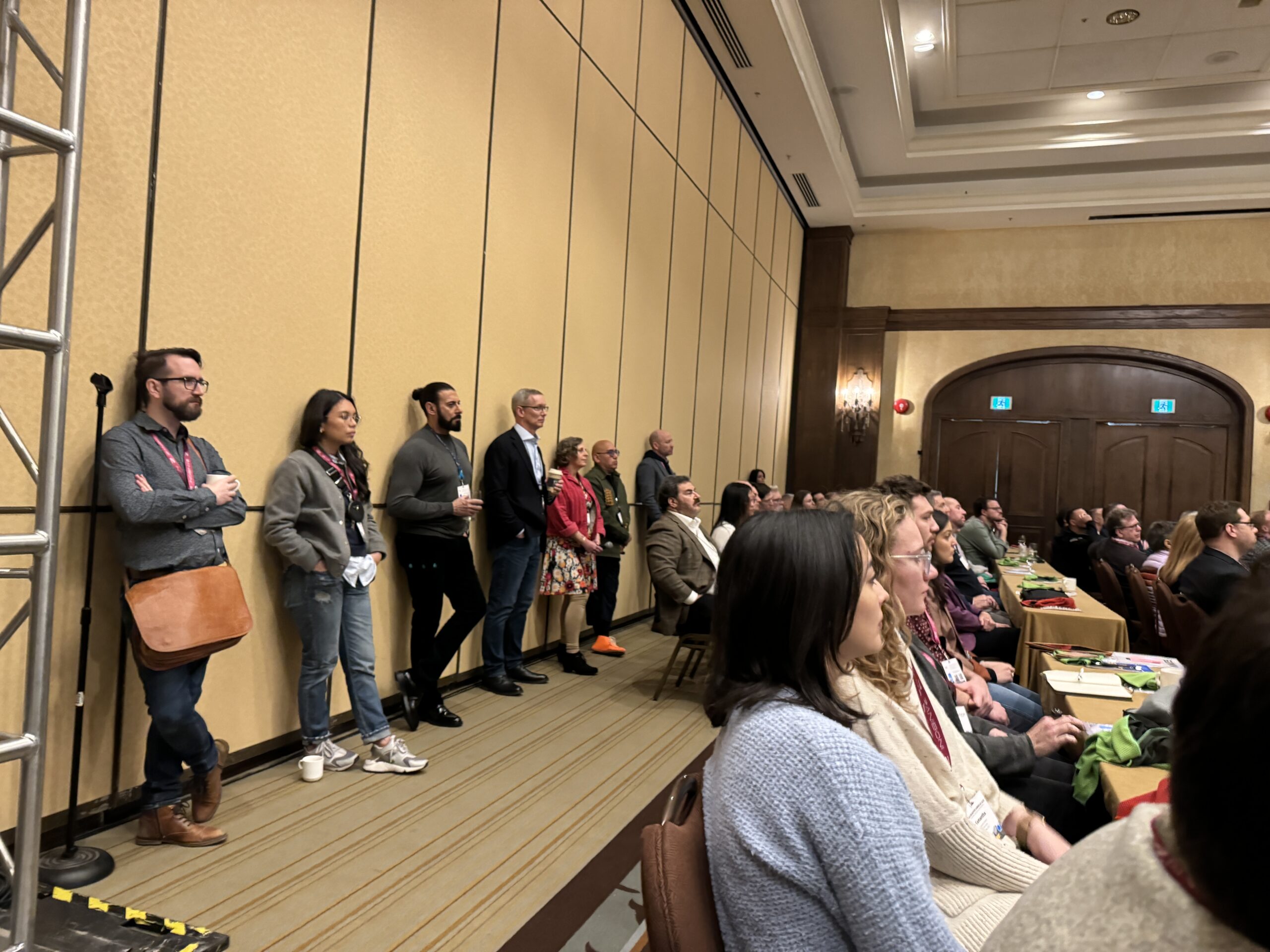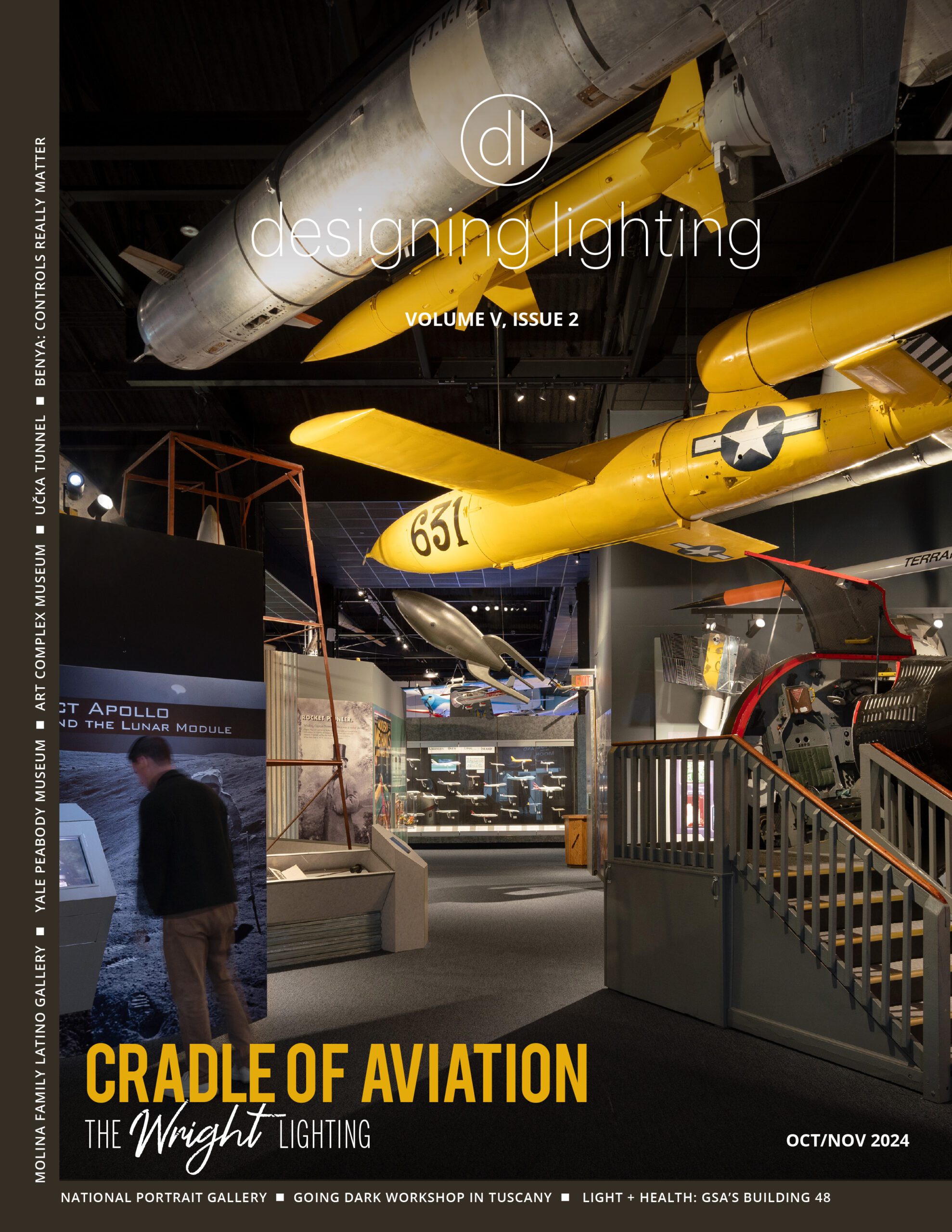Among a packed schedule of sessions at the IALD Enlighten Americas Conference last week, one that stood out was “Achieving Focus: How Lighting Designers Can Successfully Navigate the Lighting Channel,” expertly led by Steven Rosen from Available Light. The panel featured a lineup of industry experts: Alexis Arnoldi from Cline Bettridge Bernstein, Jimalee Beno of Focal Point Lighting, and Nancy Stathes from Specialty Lighting Industries.

Panelists Steven Rosen (moderator), Alexis Arnoldi, Jimalee Beno, and Nancy Stathes
To facilitate live polling at the onset of the session, attendees were given red and green flags. The use of these flags during the session revealed a room roughly divided equally between designers and manufacturers.

The Channel
Steven Rosen opened the session by highlighting a common end goal shared by all: the completion of a job. However, he pointed out the differing objectives encountered throughout the process. Insights from surveys distributed before the meeting included a few key points:
- Lighting designers often do not engage in the transactional part of projects, which can leave them feeling isolated in their quest for quality.
- The lack of transparency within the sales channel can be both crippling and disheartening for those involved.
The first Pop-Up question: “Designers, do you prefer to work with your rep or direct to the manufacturer?”
Alexis Arnoldi noted the advantage of working with representatives, especially when navigating larger companies. She remarked, “I work with great reps and know that they will get the answers. With larger companies, the rep will know who to go to get the answer. With smaller companies, I know who to go to, but with larger companies, I don’t.”
Jimalee Beno, representing the manufacturing perspective, highlighted the limitations of manufacturers in problem-solving compared to representatives, pointing out that manufacturers have “a small basket of things to offer to solve problems,” whereas “reps have a larger basket.”
An LA-based designer outlined their office rule which emphasizes the importance of representatives, stating, “We always go first to the reps. Most products we spec, we know someone at the manufacturer, but we hold more power with the rep than the manufacturer, and the rep is scared to screw up.”
A Toronto-based designer noted the importance of a representative’s responsiveness, saying, “It depends on how good the rep is; some agents take four days to answer a question.” Jimalee, from the manufacturing side, humorously concluded her view on the discussion, “We don’t have a goal: I hope I can find the most non-responsive rep in town.”

The Journey Traveled
The second Pop-Up question was: “Designers, are you seeing more out of territory spec work than in previous years?” About half of the designers raised their hands. When the same question was put to manufacturers, most thought things were status quo, meaning they were NOT seeing an increase in that activity.
Jimalee reported an increase in out-of-territory specifications “since Andrea changed things.” I spoke to her later to clarify and as I suspected she was referring to Andrea Hartfrant’s method of territorial expansion. This leads to the question: when a designer is based in a different city from the principal’s, which representative should be credited for the design work? Jill Cody from Dark Light Design described the difficulties of managing multiple offices and the complexities of remote work, particularly when pre-existing relationships with local representatives exist.” She stated, “They want to keep their local rep relationships, but I don’t want their local rep calling on them because that local rep is not going to get paid.”

Survey Question
A third question: “Designers, do you carry fees in your contract to protect your jobs from nuisance VE moves by the Channel?” In response, about 25% of the designers raised their flags—some even before Steven had finished posing the question. One designer commented, “When a rep value engineers a project without communicating with us, they lose our trust. I no longer trust them and want to work with direct with the manufacturer.” Michael from Los Angeles explained that he lists the rep on the spec with the rep’s contact information because so much of his work is out of territory.
The subject turned to overage. Nancy Stathes stated, “Reps don’t have the right to price gouge—a manufacturer can pull that in. If the project is out of wack financially and the agent is misbehaving; we have the ability to correct that.”
Another designer commented, “When a manufacturer shows me a product and I ask what it sells for, and then they turn to the rep, that tells me that they allow the rep to set the pricing.” Jimalee defended that practice saying every market is different, and because there is distributor and contractor mark up, the rep is better suited to know the local market conditions than the manufacturer.
The next Pop-Up question: “Designers, should you care if the local rep gets credit for projects outside of their territory?” Most agreed. The same thing was true with the manufacturers. The consensus is that the role of the rep is key and everyone wants to ensure the rep who does the work is fairly compensated.
Andrea Hartranft, of HLD, explained the importance of respecting reps, “When not in territory, some poor dude or dudette is saddled to helping us because the manufacturer, or we, did not quite get something right. We want to take care of the community because we need the community to take care of us.”
The next Pop-Up question: “Designers, do you regularly copy your reps on your lighting fixture schedule and do you and brief them before the package is released to the sharks?” Almost all designers did copy the reps. There was much discussion about the importance of the reps and if the designer works with the rep, the rep will usually help protect the spec.
Returning to the subject of overage, Shoshanna Seegal, of HLD, stirred the audience when she asked to see a show of hands of manufacturers who explicitly exclude overage in their contracts. Zero hands. There was a round of applause when someone suggested public pricing.
Paul Boken from The Sourcery said all problems are solved when everyone is in the room together, including the rep. When he was a designer, he brought everyone in and sometimes it was awkward especially during the pricing discussion, but everyone left the meeting knowing what was expected.

Standing Room Only at the session: Achieving Focus: How Lighting Designers Can Successfully Navigate the Lighting Channel
Steven ended the session by showing some comments from Journalist. We usually get left out of these sorts of discussions, so I found it quite refreshing. A few comments:
- Manufacturers and reps have the closest relationships.
- Lighting designers are the most transparent in the channel; they don’t have financial skin in the game—until their time is wasted.
- Reps seem to have the most to gain by improving relationships across industry roles as their commission is most impacted by product substitutions.
The session provided straightforward and practical insights into the collaborative dynamics between lighting designers, manufacturers, and representatives. The discussion highlighted the critical importance of clear communication and solid relationships within the industry. It became evident that the role of manufacturer’s reps extends beyond that of a liaison, playing a crucial part in project success and efficiency. The session underscored the need for transparency and responsiveness to maintain trust and the value of strategic partnerships in achieving the shared goal of project completion. As we reflect on the diverse perspectives shared, one thing is clear: maintaining and improving these relationships is essential for the seamless execution of lighting projects, and all parties must work together effectively to navigate the industry’s challenges.




